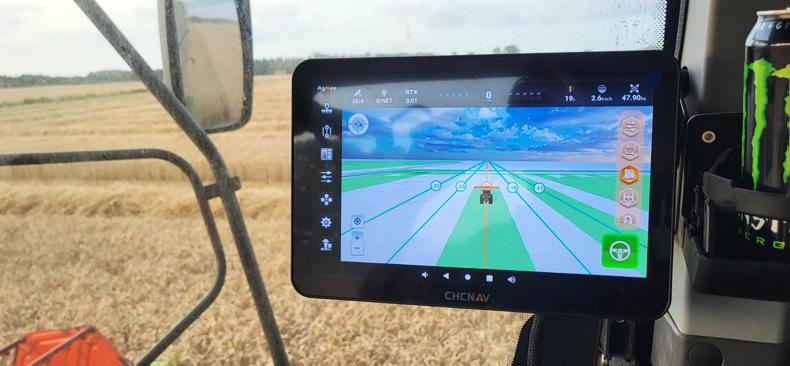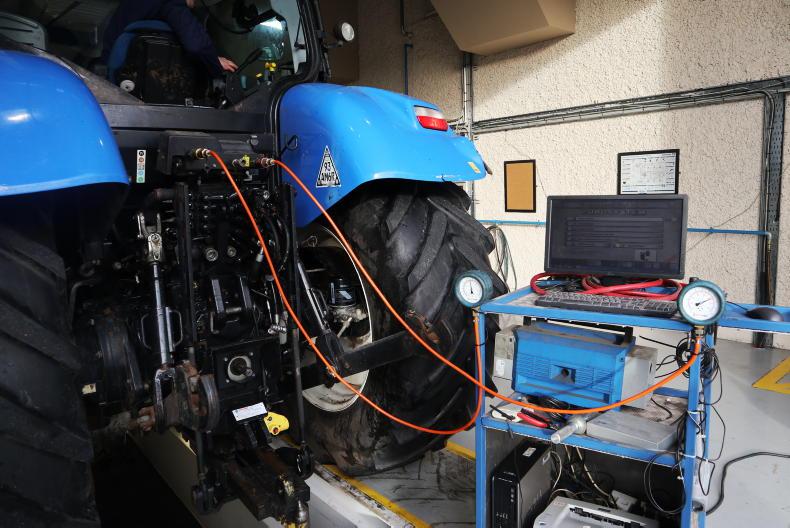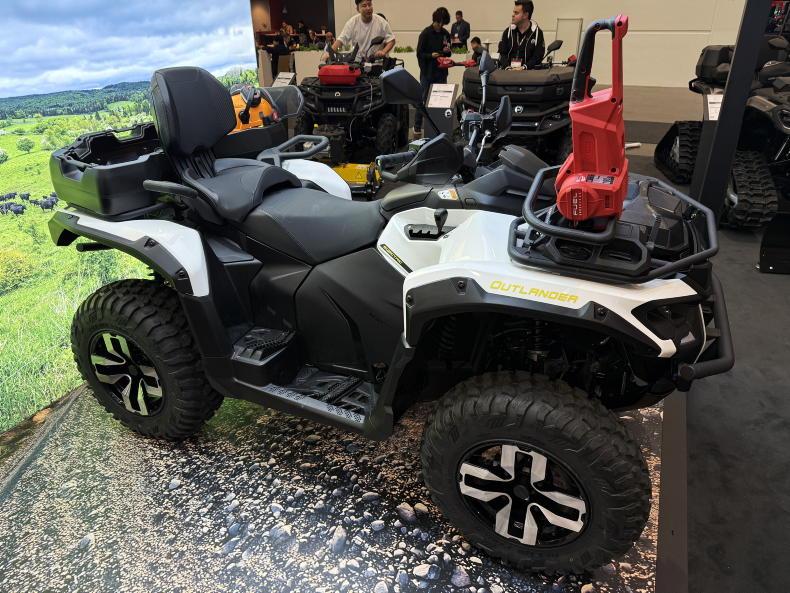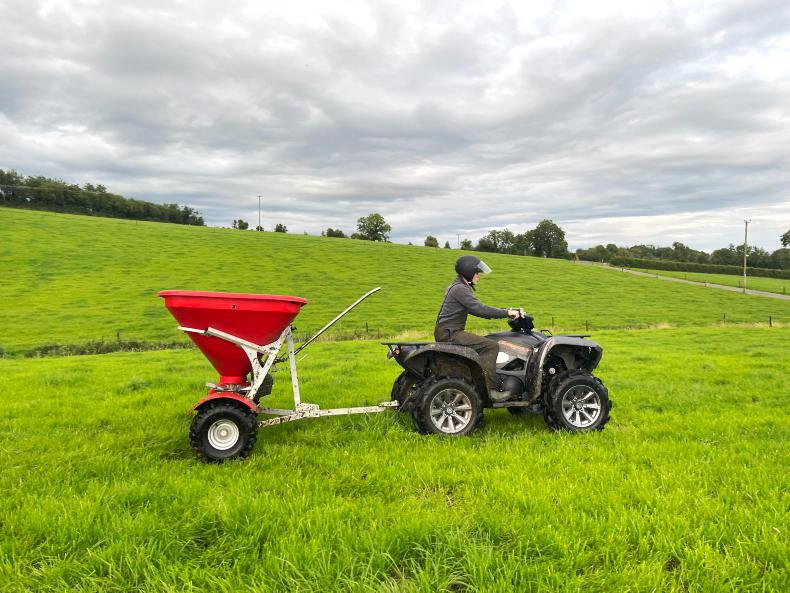Today, more and more utility quads are verging towards the recreational side of the house as opposed to being heavy-duty work horses as we tend to expect as agricultural users.
When I think of the terms, workhorse and quad, I think of the Honda Foreman from the mid 2000s – a strong dependable do-all machine, many of which are still standing the test of time on Irish farms today. Since the arrival in 2019 of the current generation 500 and 750 AXi KingQuad models, Suzuki has gained notable traction within the market.
Quadfactors, Kells, Co Meath, supplied us with a Suzuki KingQuad 750AXi Power steering model to find out just how well it performs.
Appearance and build
Having personally seen the KingQuad (red model) parked alongside the current Honda Foreman TRX 520, there are some major similarities in terms of styling, especially when the extended fenders have been removed.
Although not necessarily a bad thing, these similarities go back beyond the current generation.

The KingQuad 750 AXi is fitted with a 722cc single-cylinder engine.
Our initial and lasting impression was that the KingQuad is well built. The plastics are of good quality and better than some competitors, as the strength is where it needs to be.
This was especially apparent in the load-bearing areas such as the foot wells, an area subject to the rider’s weight thousands of times over its working life. These footwells are well-supported underneath by the chassis.

Independent double wishbone suspension is used on the front and rear.
The lack of a front bull bar, as standard, is a let-down. Although standard with competitor models, Suzuki maintains that the front bumper moulding is built ruggedly to withstand a certain degree of abuse.
At the end of the day, it’s still only plastic and no replacement for a steel tubular bull bar. That said, for those who want to dig deeper into their pockets, they can fork out an additional €350 for the bull bar option.

Both, riding position and control layout cannot be faulted.
Compared with the previous generation, the current KingQuadfeatures a beefed-up frame with thicker main frame tubes and stronger suspension mounting points.
Both the 500 and 750 AXi models are rated to tow 600kg, carry 30kg on the front and 60kg on the rear racks, all of which are respectable figures.
Engine and transmission
The 750 AXi is equipped with a 722cc, DOHC single-cylinder, four-valve engine. Almost an industry standard at this point, it is fuel-injected and water-cooled.

The KingQuad is rated to tow 600kg.
The engine block is cantered forward 480 in order to lower the overall centre of gravity.
As you’d expect from a quad of such capacity, there is no shortage of torque at low rpm, meaning we rarely needed to call on the engines full rev range for the majority of tasks.
The only downside is that the engine doesn’t have the same sweet sounding note that its closest competitors have in the mid rev range and under load. But, one thing for sure is that when you pin back the throttle and point the handle bars in a particular direction, the delivery of power is rapid.

Shifting between gears is effortless.
Having been present for the run in service, we can confirm that all service points are easily accessed. For those that matter or find themselves wading through deep water, the air intake is mounted at the highest point of the body for optimum clearance.
The engine will start in any gear once the left hand brake lever is pulled, a feature we found by chance and avoids unnecessary fumbling to find neutral.
This smoothly brings us on to what we feel is the KingQuad’s bestselling point, its transmission which is also silk smooth.

The rear fenders are crude looking but practical.
Like the majority of its competitors, with the exception of, Honda, Suzuki uses its low maintenance QuadMatic CVT-type belt-driven transmission.
Honda still opts to use its dual clutch automated powershift setup. As expected, there are high and low forward ranges, as well as neutral and reverse.
Unlike some brands which require considerable persuasion when changing gears, Suzuki has nailed gear selection with effortless shifts of the lever through its dog leg-gate.
But, if we were to change anything about the transmission, it would be the addition of a park position and to reposition the gear lever closer to the rider, leaving it less of a reach.

We feel that the ignition switch would be better located below the dash screen.
For more demanding tasks such as pulling the farm’s 500kg Walco fertiliser spreader, the low range proves its worth.
Other than that, we mainly found ourselves in the high range for light tasks. The selectable 4WD and differential lock system is straightforward and does as it says on the tin.
Suspension, handling and brakes
Suzuki uses an independent front and rear double wishbone suspension setup, again almost an industry standard at this stage.
Offering 7in of front and rear travel, the coil springs are gas charged and oil damped with five-way preload adjustment.

The full quota of the 722cc engine is really only called into action when pulling heavier loads like a 500kg fertiliser spreader.
The rear shock preload on our unit needed adjustment to prevent ‘squatting’ when the rear fence box was mounted.
All round comfort couldn’t be faulted with the chassis proving as rigid as we would like for farm use, in the sense that cargo racks could be loaded without leaving it feeling unstable.
Once seated, riding position is good and the thickly padded seat helps in terms of comfort and support.
Handlebar positioning may be a little higher than its closest rivals which isn’t necessarily a bad thing.
Suzuki uses outboard disc brakes up front and an inboard, oil immersed multi-disc system on the rear.
The park brake is a lock which clamps the lefthand brake lever in its pulled position.
The level of engine braking is pretty solid, but not as effective as the multi-stage system on the new Can-am Outlander. The electronically assisted steering system leaves handling predictable but not too disconnected from reality. It’s a well-designed system that is really only noticeable at low speeds.

One of our faults with the KingQuad range is that it lacks a front bull bar as standard.
Other features
The instrument cluster is sizeable and easy to read. The three-headlight setup is worked from the ignition switch while switching between dip and main beams is done from the left handlebar. However, we question why Suzuki couldn’t have fitted LED headlights when the rear is LED? Storage is ample. There is one waterproof storage bin up front and two further compartments at the rear. There is also a 12v power socket on the right fender.
KingQuad 500 v 750?
Having tried out both models back to back and taking into account that the only difference is the larger displacement engine, the question we asked ourselves was whether or not the 722cc (750 AXi) engine is of any benefit over the 493cc (500 AXi) model for most faming situations. The answer is that it depends on the farm’s requirements.
If little to no haulage work is undertaken then we would say no. But, if the intention is to pull a half-tonne spreader or similar then the extra grunt is worthwhile. However, it comes to a point where weight and traction become the limiting factor and not so much the power.
The 750 does perform lighter tasks at lower engine rpm.
The increase is fuel is notable, but not excessive.
Verdict
Our gripes with the KingQuad 750Axi are minor. Firstly, the positioning of the combined ignition/headlight switch feels poorly thought out and a stretch from riding position. Like on the Honda, we feel this would be better placed below the speedometer.
Accessing the fuel filler cap with a rear cargo/fencing box isn’t all that straightforward, albeit manageable.
The rear fender kits fitted to all models sold on the EU market are practical, but a slight bit flimsy and crude looking. Nevertheless, after 200 hours, the KingQuad 750Axi does live up to the name in almost all situations, punching well above its weight.
Having tested a number of quads in recent years, it is one of the best farm/utility ATVs on the market currently. It offers the full package in terms of build quality, comfort and performance while being slightly more competitive priced in comparison to its other premium brand rivals.
Good all round performer.Seamless gear shifts.Build quality. Ignition switch location.Lacks a transmission park position.Engine: 722cc single-cylinder. Power: 48hp.Transmission: CVT stepless belt drive with selectable 4wd. Differentials: lockable front.Suspension: independent front and rear double wishbone.Towing capacity: 600kg.Carrying capacity: 30kg front and 60kg rear.Ground clearance: 260mm.Dry weight: 329kg.Starting price: €10,161 plus VAT.
Today, more and more utility quads are verging towards the recreational side of the house as opposed to being heavy-duty work horses as we tend to expect as agricultural users.
When I think of the terms, workhorse and quad, I think of the Honda Foreman from the mid 2000s – a strong dependable do-all machine, many of which are still standing the test of time on Irish farms today. Since the arrival in 2019 of the current generation 500 and 750 AXi KingQuad models, Suzuki has gained notable traction within the market.
Quadfactors, Kells, Co Meath, supplied us with a Suzuki KingQuad 750AXi Power steering model to find out just how well it performs.
Appearance and build
Having personally seen the KingQuad (red model) parked alongside the current Honda Foreman TRX 520, there are some major similarities in terms of styling, especially when the extended fenders have been removed.
Although not necessarily a bad thing, these similarities go back beyond the current generation.

The KingQuad 750 AXi is fitted with a 722cc single-cylinder engine.
Our initial and lasting impression was that the KingQuad is well built. The plastics are of good quality and better than some competitors, as the strength is where it needs to be.
This was especially apparent in the load-bearing areas such as the foot wells, an area subject to the rider’s weight thousands of times over its working life. These footwells are well-supported underneath by the chassis.

Independent double wishbone suspension is used on the front and rear.
The lack of a front bull bar, as standard, is a let-down. Although standard with competitor models, Suzuki maintains that the front bumper moulding is built ruggedly to withstand a certain degree of abuse.
At the end of the day, it’s still only plastic and no replacement for a steel tubular bull bar. That said, for those who want to dig deeper into their pockets, they can fork out an additional €350 for the bull bar option.

Both, riding position and control layout cannot be faulted.
Compared with the previous generation, the current KingQuadfeatures a beefed-up frame with thicker main frame tubes and stronger suspension mounting points.
Both the 500 and 750 AXi models are rated to tow 600kg, carry 30kg on the front and 60kg on the rear racks, all of which are respectable figures.
Engine and transmission
The 750 AXi is equipped with a 722cc, DOHC single-cylinder, four-valve engine. Almost an industry standard at this point, it is fuel-injected and water-cooled.

The KingQuad is rated to tow 600kg.
The engine block is cantered forward 480 in order to lower the overall centre of gravity.
As you’d expect from a quad of such capacity, there is no shortage of torque at low rpm, meaning we rarely needed to call on the engines full rev range for the majority of tasks.
The only downside is that the engine doesn’t have the same sweet sounding note that its closest competitors have in the mid rev range and under load. But, one thing for sure is that when you pin back the throttle and point the handle bars in a particular direction, the delivery of power is rapid.

Shifting between gears is effortless.
Having been present for the run in service, we can confirm that all service points are easily accessed. For those that matter or find themselves wading through deep water, the air intake is mounted at the highest point of the body for optimum clearance.
The engine will start in any gear once the left hand brake lever is pulled, a feature we found by chance and avoids unnecessary fumbling to find neutral.
This smoothly brings us on to what we feel is the KingQuad’s bestselling point, its transmission which is also silk smooth.

The rear fenders are crude looking but practical.
Like the majority of its competitors, with the exception of, Honda, Suzuki uses its low maintenance QuadMatic CVT-type belt-driven transmission.
Honda still opts to use its dual clutch automated powershift setup. As expected, there are high and low forward ranges, as well as neutral and reverse.
Unlike some brands which require considerable persuasion when changing gears, Suzuki has nailed gear selection with effortless shifts of the lever through its dog leg-gate.
But, if we were to change anything about the transmission, it would be the addition of a park position and to reposition the gear lever closer to the rider, leaving it less of a reach.

We feel that the ignition switch would be better located below the dash screen.
For more demanding tasks such as pulling the farm’s 500kg Walco fertiliser spreader, the low range proves its worth.
Other than that, we mainly found ourselves in the high range for light tasks. The selectable 4WD and differential lock system is straightforward and does as it says on the tin.
Suspension, handling and brakes
Suzuki uses an independent front and rear double wishbone suspension setup, again almost an industry standard at this stage.
Offering 7in of front and rear travel, the coil springs are gas charged and oil damped with five-way preload adjustment.

The full quota of the 722cc engine is really only called into action when pulling heavier loads like a 500kg fertiliser spreader.
The rear shock preload on our unit needed adjustment to prevent ‘squatting’ when the rear fence box was mounted.
All round comfort couldn’t be faulted with the chassis proving as rigid as we would like for farm use, in the sense that cargo racks could be loaded without leaving it feeling unstable.
Once seated, riding position is good and the thickly padded seat helps in terms of comfort and support.
Handlebar positioning may be a little higher than its closest rivals which isn’t necessarily a bad thing.
Suzuki uses outboard disc brakes up front and an inboard, oil immersed multi-disc system on the rear.
The park brake is a lock which clamps the lefthand brake lever in its pulled position.
The level of engine braking is pretty solid, but not as effective as the multi-stage system on the new Can-am Outlander. The electronically assisted steering system leaves handling predictable but not too disconnected from reality. It’s a well-designed system that is really only noticeable at low speeds.

One of our faults with the KingQuad range is that it lacks a front bull bar as standard.
Other features
The instrument cluster is sizeable and easy to read. The three-headlight setup is worked from the ignition switch while switching between dip and main beams is done from the left handlebar. However, we question why Suzuki couldn’t have fitted LED headlights when the rear is LED? Storage is ample. There is one waterproof storage bin up front and two further compartments at the rear. There is also a 12v power socket on the right fender.
KingQuad 500 v 750?
Having tried out both models back to back and taking into account that the only difference is the larger displacement engine, the question we asked ourselves was whether or not the 722cc (750 AXi) engine is of any benefit over the 493cc (500 AXi) model for most faming situations. The answer is that it depends on the farm’s requirements.
If little to no haulage work is undertaken then we would say no. But, if the intention is to pull a half-tonne spreader or similar then the extra grunt is worthwhile. However, it comes to a point where weight and traction become the limiting factor and not so much the power.
The 750 does perform lighter tasks at lower engine rpm.
The increase is fuel is notable, but not excessive.
Verdict
Our gripes with the KingQuad 750Axi are minor. Firstly, the positioning of the combined ignition/headlight switch feels poorly thought out and a stretch from riding position. Like on the Honda, we feel this would be better placed below the speedometer.
Accessing the fuel filler cap with a rear cargo/fencing box isn’t all that straightforward, albeit manageable.
The rear fender kits fitted to all models sold on the EU market are practical, but a slight bit flimsy and crude looking. Nevertheless, after 200 hours, the KingQuad 750Axi does live up to the name in almost all situations, punching well above its weight.
Having tested a number of quads in recent years, it is one of the best farm/utility ATVs on the market currently. It offers the full package in terms of build quality, comfort and performance while being slightly more competitive priced in comparison to its other premium brand rivals.
Good all round performer.Seamless gear shifts.Build quality. Ignition switch location.Lacks a transmission park position.Engine: 722cc single-cylinder. Power: 48hp.Transmission: CVT stepless belt drive with selectable 4wd. Differentials: lockable front.Suspension: independent front and rear double wishbone.Towing capacity: 600kg.Carrying capacity: 30kg front and 60kg rear.Ground clearance: 260mm.Dry weight: 329kg.Starting price: €10,161 plus VAT. 

















SHARING OPTIONS